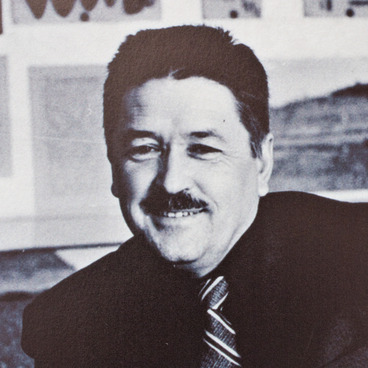This is a photograph of an archaeologist, anthropologist and Doctor of Historical Sciences Mikhail Gerasimov. In his hands he is holding a bust, which he reconstructed using his own method, based on bones and skull fragments. This method, which helped to reconstruct the faces of the early humans, was named after the author — ‘the Gerasimov’s method’.
Mikhail Gerasimov was born in 1907 in St. Petersburg. When the future archaeologist was young, the family moved to Irkutsk, where his father worked as the head of the medical unit of the resettlement center. From the age of 11, Gerasimov participated in archaeological excavations on Verholenskaya Mountain in the suburbs of Irkutsk. At the age of 13, he began working at the Anatomical Museum at the Medical Faculty of Irkutsk State University. There he studied how the soft tissues of the face are attached to the bones of the skull.
In 1922, Gerasimov went to work at the Irkutsk Museum of Local Lore, and three years later, when he was 18, the archaeologist published his first scientific article in the journal “Local history of the Irkutsk governorate” about old graves near the Innokentievskaya station (now Irkutsk-2).
When Gerasimov was 21, he made the main discovery of his archaeological career — an early human burial site in the village of Malta, which was called one of the pearls of the Paleolithic era. There, archaeologists for the first time found female bone figurines on the territory of Siberia — before that they had been only found in Europe. Also in Malta, a new technique was used for the first time: the settlements were excavated in layers, and then completely cleared of earth and sand.
In the late 1920s, Gerasimov began working with the remains of the early humans: he reconstructed their appearance from their skeletons. In 1932, the archaeologist entered a graduate program and moved to Leningrad, where in his spare time he worked at the Hermitage Museum.
Since 1937, Mikhail Gerasimov became a senior research scientist at the Institute for the History of Material Culture of the Russian Academy of Sciences. He reconstructed the look of the early humans, as well as historical figures: Yaroslav the Wise, Andrei the Pious and Ivan the Terrible.
In total, Mikhail Gerasimov performed more than 200 facial reconstructions.
Mikhail Gerasimov was born in 1907 in St. Petersburg. When the future archaeologist was young, the family moved to Irkutsk, where his father worked as the head of the medical unit of the resettlement center. From the age of 11, Gerasimov participated in archaeological excavations on Verholenskaya Mountain in the suburbs of Irkutsk. At the age of 13, he began working at the Anatomical Museum at the Medical Faculty of Irkutsk State University. There he studied how the soft tissues of the face are attached to the bones of the skull.
In 1922, Gerasimov went to work at the Irkutsk Museum of Local Lore, and three years later, when he was 18, the archaeologist published his first scientific article in the journal “Local history of the Irkutsk governorate” about old graves near the Innokentievskaya station (now Irkutsk-2).
When Gerasimov was 21, he made the main discovery of his archaeological career — an early human burial site in the village of Malta, which was called one of the pearls of the Paleolithic era. There, archaeologists for the first time found female bone figurines on the territory of Siberia — before that they had been only found in Europe. Also in Malta, a new technique was used for the first time: the settlements were excavated in layers, and then completely cleared of earth and sand.
In the late 1920s, Gerasimov began working with the remains of the early humans: he reconstructed their appearance from their skeletons. In 1932, the archaeologist entered a graduate program and moved to Leningrad, where in his spare time he worked at the Hermitage Museum.
Since 1937, Mikhail Gerasimov became a senior research scientist at the Institute for the History of Material Culture of the Russian Academy of Sciences. He reconstructed the look of the early humans, as well as historical figures: Yaroslav the Wise, Andrei the Pious and Ivan the Terrible.
In total, Mikhail Gerasimov performed more than 200 facial reconstructions.



